How to Build a Community from Scratch (2024)

Individuality. Wanting to be totally different from others.
Does this concept kill the idea of communities?
I say, absolutely not!
(Many) people still love being part of a group of like-minded individuals.
Some might say forming connections with those holding similar:
- values
- desires
- and aspirations
…is more critical than ever.
The great news?
Technology allows you to set up online communities for your people in just a few clicks.
And having built multiple successful ones, I know what it takes to succeed in online community-building
In this article, I’ll show you how to build a community from scratch using the process I used to attract more than 4000 members to my groups.
Section 1: Setting the Foundation
Building a strong community is no easy feat.
There are multiple bumps along the way to creating an environment where everyone feels included.
That’s why setting the foundations right will make such a big difference.
Define Your Purpose, Niche & Target Audience
What is the passion driving your desire to build a community?
Is it to provide a supportive space for a specific hobby or interest?
Is it to work together to overcome frequent obstacles people in your niche deal with?
Or is it to foster connections and belonging within a particular industry or demographic?
Clearly articulating your “why” will guide all your future decisions.
It’ll also help zero in on the problems that bug your audience most.
Knowing your niche will help you understand what people are hoping for so you can meet those needs directly.
Do Your Research
Conducting thorough audience research is crucial at this stage.
Examine your average person’s various characteristics.
These can include a person’s life stage (age), place of residence (location), personal passions, and even leisure activities (interests).
Then, (even as you build community online) evaluate specific issues causing them distress (pain points) alongside typical actions taken across digital platforms (online behavior).
The more specific your research is, the better you can tailor your community to their preferences.
Focus On What Brings People Together
You’ll notice that the best online communities have genuine camaraderie.
When this happens, people are eager to help each other out.
Whether it’s through shared hobbies or local projects, this builds lasting relationships you won’t find elsewhere – and that’s why people stay in the best branded communities for a long time.
To get the same results, it’s helpful to consider your community’s distinct competitive advantage.
Is it expert-led discussions, exclusive content, or specialized tools and resources?
Laying down this groundwork means you’ll soon see people turn into dedicated fans rallying behind everything you share.
It’s important to resist the temptation to be everything to everyone.
Picking out one niche to specialize in allows you to create a group with common goals.
The result? Group members will be drawn to the specialized value you offer.
Choose Your Platform
Deciding on the go-to platform isn’t always easy.
To ensure success, consider what you require from your platform:
- ease of use
- advanced features
- easy communication.
You’ll also need to weigh the pros and cons of free vs. paid community platforms.
For beginners, using free sites such as Facebook Groups or LinkedIn Communities might work.
However, it’s not something I suggest.
You’ll end up having limited control over the user experience and branding.
Platforms like Mighty Networks or LearnWorlds offer more customization and features.
They also offer smooth content management functions and advanced analytics to measure performance accurately (more on this later).
Personally, I find Skool fantastic.
It combines excellent features from multiple platforms with an intuitive design anyone can use.
Skool also offers a range of engagement tools, content management capabilities, and advanced analytics.
Even better, it’s all done within a highly customizable, brand community environment.
Section 2: Building the Community
With the foundation laid, it’s time to start actively building your community.
Doing this right will build a branded community of people who know, like, and trust you.
Set-Up
Before officially launching your community, there are a few key set-up items to check off:
- Your Own Brand Community Design: Define your community’s brand identity. This includes the name, logo, color scheme, etc. Ensure a consistent look and feel across all platforms. Good branding builds trust and recognition.
- Guidelines & Rules: Establish clear community guidelines and rules from the start. This will set expectations for respectful conduct and allow you to handle conflicts consistently.
- Onboarding System: Create a structured onboarding process for new members. This could include welcome messages, orientation content explaining the community’s purpose and norms, and any needed profile set-up.
- Content Plan: Prepare an editorial calendar so you don’t have to get stressed about content creation. You can map out topics, formats (text, video, audio). You should also consider your content cadence. More on this in the next section.
- Engagement Strategy: Identify tactics to spark conversations and encourage participation. This includes asking questions, gamification, regular events or AMAs. An engaged community retains members.
- Moderation Plan: Decide how you’ll monitor the community space and uphold guidelines. Will you have moderator roles? Automated filtering?
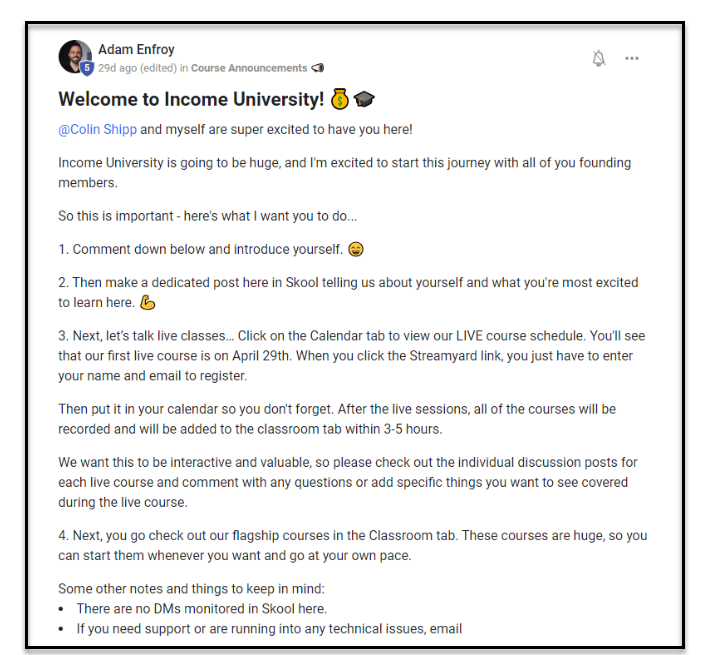
Create Compelling Content
Once the technical foundation of your community is in place, it’s time to start creating content that will attract and engage your members.
You can do this through varied content, including:
- engaging articles
- an insightful video series
- thought-provoking podcasts
- interactive live sessions
- course content.
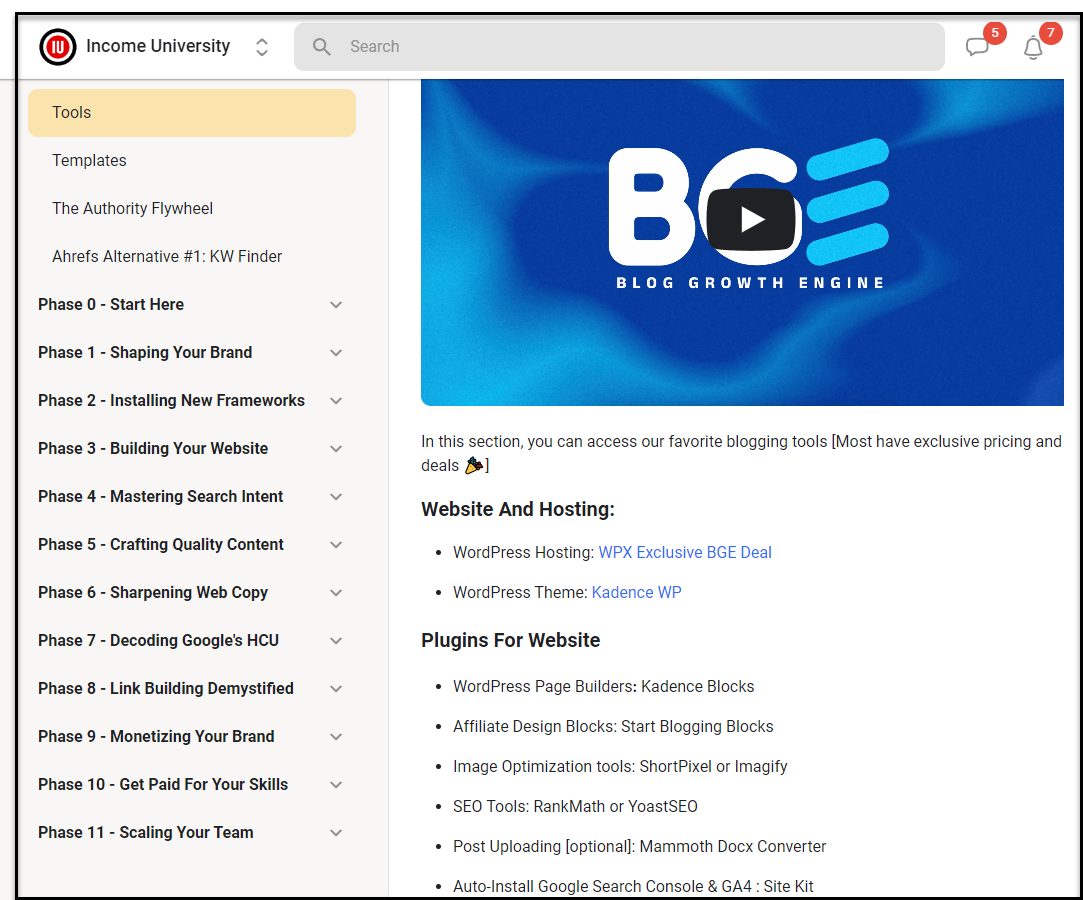
What’s important is keeping what you learned about your audience in mind in all the content you create.
Having users contribute their own material can also make a big difference.
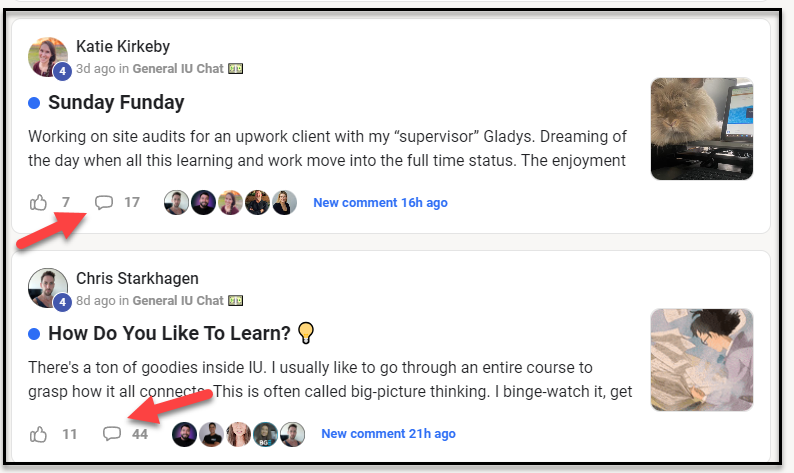
Ask people to share what they’ve learned or gone through.
This is a great way to make them care about the group’s growth as much as you do!
User-generated content can be in the form of forum discussions, member spotlights, or even guest blog posts.
The success of any good content strategy hinges on being reliably consistent with what you share.
How do you do this?
By developing a content calendar detailing when each piece of fresh info will go live.
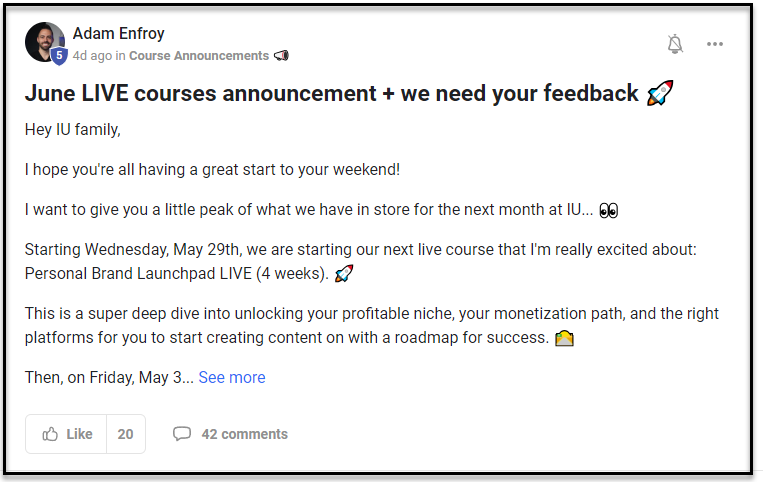
This will keep things timely and ensures you’re always offering something worth reading.
Encourage Active Participation
Building a thriving community goes beyond just creating great content.
You need to encourage participation and engagement from your members actively.
Here’s where everything starts to shine.
Kick-off discussions and post challenging questions that get people thinking.
Your aim with every post is to building community where people feel comfortable expressing opinions, sharing what they’ve been through firsthand, and making new suggestions.
Then, take the time to reply and start genuine conversations.
Doing this makes everyone feel included and appreciated.
Another aspect of active participation is putting on events and hosting webinars.
With hands-on sessions like these, members find it easier to network with others in the community.
They also get the chance to acquire new abilities and immerse themselves further within their groups.
Gamification also plays a huge role.
Turning tasks into games and offering incentives makes getting more participation easier.
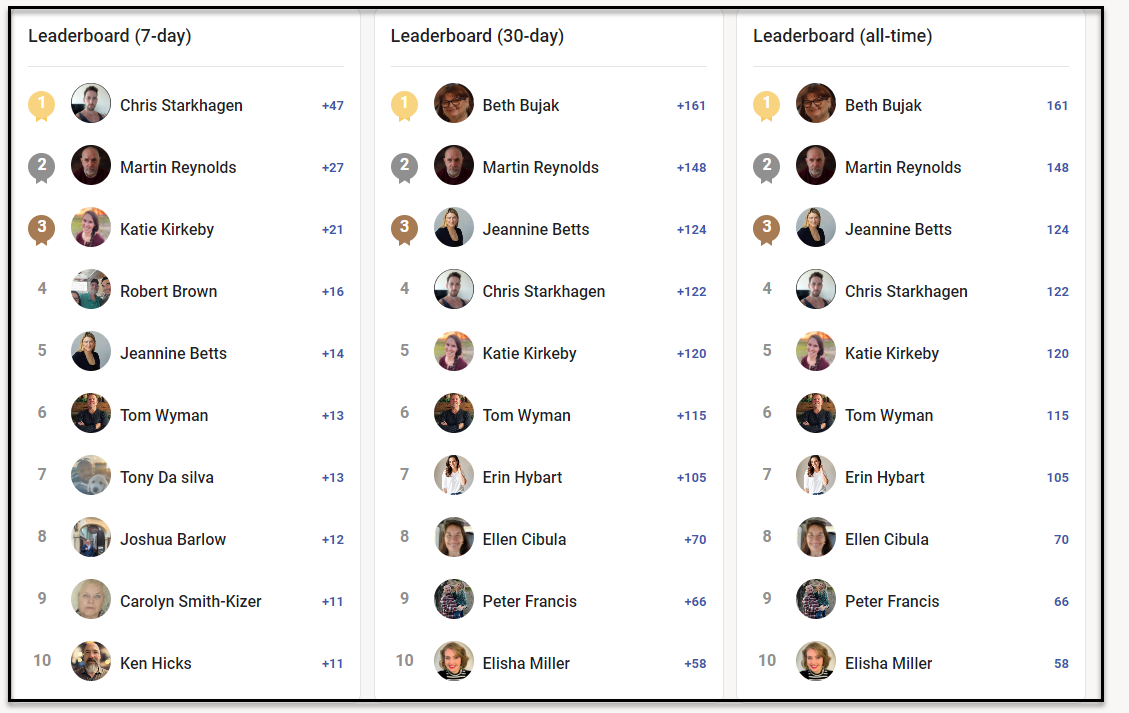
Many community platforms offer point accumulation, badge collection, or even a competitive leaderboard to consistently acknowledge those who stay engaged.
Don’t be afraid to reward those who post content, respond to inquiries, or offer help.
Offering meaningful rewards will drive more people to your community organically through word of mouth.
Section 3: Measuring Success and Adapting
Tracking your community’s progress and performance is crucial for understanding its impact.
It’s also the only way you can make informed decisions about its future.
Tracking vital statistics helps keep a close eye on performance and progress.
Let’s dive deeper into this section.
Regularly review what’s working
Keep tabs on how well you’re doing with fostering connections in the community.
Being on top of this is important for seeing both triumphs and pitfalls clearly as soon as they happen.
Doing this also ensures smarter planning of where effort—and budget—should go from here on out.
Key performance indicators (KPIs) to monitor include:
- engagement metrics (such as post frequency, comments, and reactions)
- retention rates (member activity and churn)
- conversion metrics (sales leads or revenue).
Regularly gathering and implementing member feedback is also crucial.
There are many ways to get this feedback.
The easiest methods are surveys, polls, or direct outreach.
These methods all help you better understand your community’s evolving needs and pain points.
By applying these ideas effectively, you’ll be able to know when to double down or when to pivot.
Your messaging styles will also fit what your community needs.
Section 4: Keep On (Or Start) Monetizing Your Community
Some people go for a paid community from the start.
Others prefer to build value and then make money through alternative methods.
What’s common in both situations is the focus on building a robust and engaged community.
Let’s say you’ve decided to explore additional ways to monetize your efforts.
Implementing these additional money-making methods isn’t hard when you think creatively and have a strong community.
These methods will all generate steady revenue streams while keeping engagement high.
When done right, a community is also a great place to increase FOMO (fear of missing out).
After all, when people see others getting great results (and bragging about it), they’ll want to experience the same thing.
Looking At Monetization Strategies
For starters, you can offer services such as:
- personalized consultations based on your (or other expert’s) knowledge
- sell access to specialized software and tools
- run affiliate marketing programs related directly to members’ interests
- offering useful digital downloads such as e-books or training programs
Another popular approach is offering memberships or subscription plans where members get additional features.
This is especially common when members come in for free.
Loyal community members gain VIP access to the best stuff—premium articles, advanced tools, or special events—with just a simple ongoing payment.
Another option is to implement an affiliate marketing program.
Here, you incentivize people to share the news about your community.
While you’re not making money directly, you’re increasing the number of people in your community.
And over time (especially if you offer a paid community), this will add up a lot.
When your community gets to a certain size, you should also consider sponsorships.
Brands are willing to pay good money to access an active group of people.
Just ensure that the interests of your:
- community
- sponsors
- yourself
… are all aligned.
Your monetization plan should meet both the interests and needs of those in your learning community while still maintaining high standards in everything you provide.
Community Building Challenges To Watch Out For
Building a thriving online community isn’t always an easygoing process.
Here are some of the most common pain points community builders face.
Attracting Initial Members
One of the biggest hurdles is getting the first members in the door.
Without an engaged base, creating a lively, interactive environment that attracts new people can be difficult.
And without new people, you can’t create the right environment.
So, how do you get around this?
You lean on people within your circle.
You ask them for feedback and potentially offer them free membership in exchange.
In other words, you do what you must to get the ball rolling.
You also use the right marketing tactics to get people to take action in other situations when building a community.
It’s not much different from selling a product, getting someone to opt into your list, or simply buy a service.
Keeping Members Engaged
Even after you’ve built up a solid community, keeping members actively participating is an ongoing task.
People’s attention spans are limited and competing priorities can pull them away.
Never stop:
- consistently delivering value
- starting meaningful connections and
- gamifying the community experience.
Having a full calendar goes a long way to keeping members engaged.
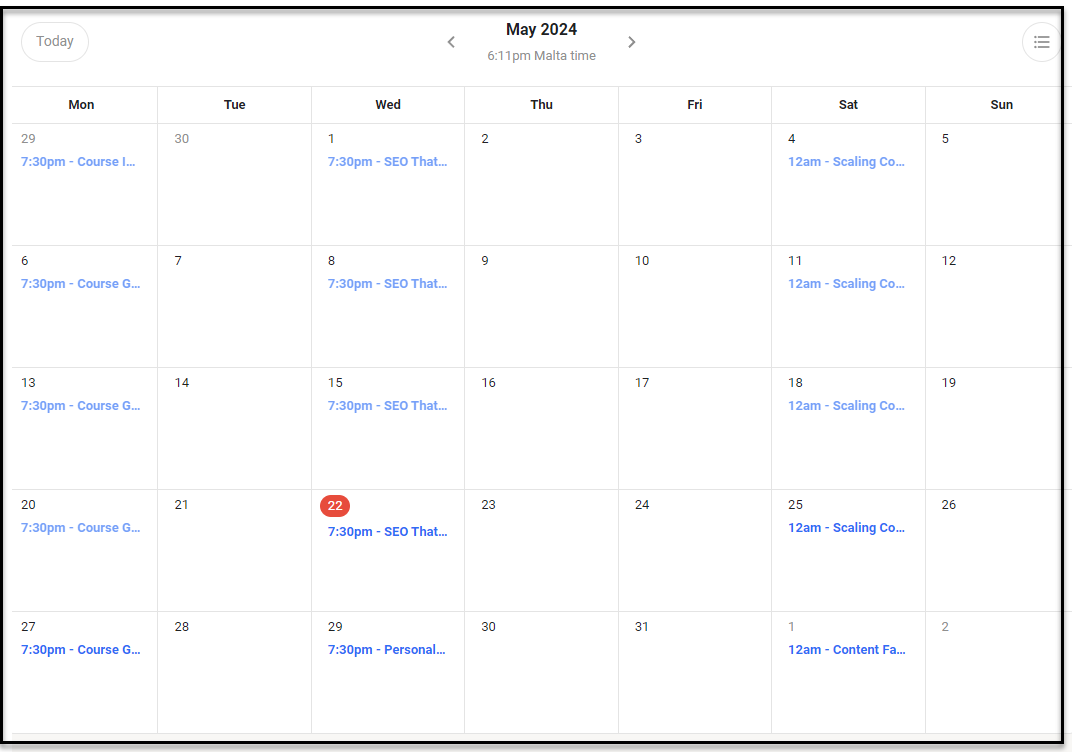
Dealing with Negativity
No community is immune to the occasional troll or disruptive member.
Handling these situations with empathy (and a firm hand) is crucial.
Make sure everyone knows the ground rules of your community.
As your community grows, you’ll also want to bring in moderators.
Empower your moderators with authority, and don’t hesitate to step in if things go south.
Keeping things running smoothly takes effort from all sides.
Cost Considerations
Building and running an online community requires financial resources.
And especially at the start, keep an eye out for costs like:
- platform fees
- third-party tools
- paying for moderators or community managers
- content creation costs
- and more…
Over time, you can also explore more economical ways to meet both current demands and long-term objectives.
Conclusion
Building a community from scratch isn’t easy.
However, it’s well worth it.
Your community will thrive when you take the time to lay a strong foundation, understand your audience, and keep people engaged.
And finally, remember that a great product (alone) isn’t enough.
A strong community helps your brand grow and succeed.
Ready to start building your community? Follow the steps above to get going.
Further reading on AdamEnfroy.com: Exploring the best tools for building your community? Here’s my advice on the best community platforms to help you find the perfect fit.
If you’re interested in sharing your knowledge with others, my guide on Learning Management Systems will come in handy.
And for those curious about the world of content creation, you can learn about the types, skills, and examples of content creators you can decide to be like.
Considering coaching as an avenue?
Discover how to launch your own business with this guide on starting a coaching business.





